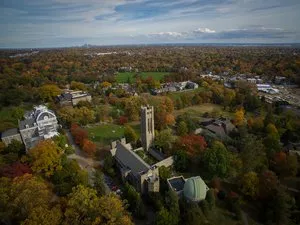Statistician Steve Wang Explores the Intersection of Statistics and Paleontology, Among Other Areas

Earlier this semester, faculty member Steve Wang and a small group of local elementary school teachers set out on a "living fossil" walk through the Crum Woods, which border Swarthmore's campus. The walk was part of the Teachers as Scholars (TAS) program, a collaboration between Swarthmore College and local school districts that aims to enrich the teaching style of local educators by making them learners again. Wang led participants through the basics of the fossil record before engaging them in the cutting-edge debates and research in which experts in the field are currently grappling. But Wang is not a professor of paleontology or anything remotely similar - he is an associate professor of statistics.
Wang has developed something of a knack for enmeshing himself in other fields. In 2006, he and University of Pennsylvania paleontologist Peter Dodson published a significant study showing that paleontologists have not yet exhumed the remains of the majority of the dinosaurs that once roamed the earth. Using a statistical method that incorporated previous dinosaur discoveries, they estimated that only 28 percent of dinosaur genera have been uncovered.
Wang's primary concern in paleontology is the incompleteness of the fossil record. In his TAS seminar, he illustrated just how imperfect the fossil record is. He offers the example of Metasequoia, a tree known to scientists exclusively through fossils, until it was discovered growing in 1944 in China. According to Wang, this shows that species can disappear from the fossil record for millions of years, even when they are not extinct. The inevitable incompleteness of the record, an inconvenience for paleontologists, is an opportunity for Wang.
"Statistics is a means for quantifying this incompleteness," he says. All data "have missing values, or missing variables, that were not measured but ideally should have been. But this incompleteness does not mean that all data are flawed and therefore meaningless."
Here, statistics proves its worth. In quantifying incompleteness, it can show the extent to which a data set is incomplete, and use that knowledge to draw substantive conclusions.
"I tell my students that one of the great things about statistics is that you can apply it to almost any area," Wang says. "My own research is an example of that."
Indeed, Wang's beginnings in paleontology are somewhat serendipitous. As a new faculty member at Harvard University in search of a research topic, Wang stumbled across a professor that listed his interests as "statistical paleontology" on the biology department web page, and scheduled a meeting.
"I was interested in dinosaurs as a little kid, but I never thought about becoming a paleontologist," he says. "I thought paleontologists just dug up dinosaur bones in the desert. But I found out that paleontology is a rich source of challenging and interesting statistical problems, and I've been working on that ever since."
But Wang's interest extends well beyond paleontology. He has also applied statistical methods to baseball. A life-long Yankees fan, Wang used a method called Chernoff faces that uses facial expressions to display data about baseball managers, enabling him to analyze how the strategies of team managers overlap and differ.
In his classes, he has developed something of a reputation for his eclectic applications of statistics, using examples from global warming, discrimination on juries, and low-carb diets. In 2008, the American Statistical Association awarded him the Waller Education Award for his innovative approach to education.
Wang wants his students to "see how powerful statistics is," he says. "It can be useful in almost any subject. Anyone can benefit from being statistically literate."



